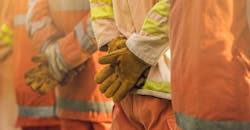4 Ways to Kickstart the FR/AR Selection Process for Global Teams
The global pandemic has brought many firsts for the general population, including an interest in and understanding of personal protective equipment (PPE). For safety directors, procurement managers and other individuals responsible for outfitting workforces in hazardous industries, the PPE landscape has been an integral part of industrial safety programs for decades. But just because you know PPE goes beyond face coverings, it doesn’t make the selection process any easier. Add in the complexities of a workforce that crosses international borders, and the task can feel daunting.
For individuals responsible for the selection of flame-resistant, arc-rated (FR/AR) apparel, there’s an easy path forward. Start with these four steps and you’ll be on your way to more confident decision-making to protecting your global workforce.
1. Start with a Local Safety Hazard Assessment
The first thing to remember when undertaking the responsibility of ensuring teams across multiple countries have the FR/AR apparel they need is to accept that you can’t take a one-size-fits-all approach. With no global governing body in place, it’s important to take extra considerations for each region. You can start by connecting with local health and safety organizations, such as the Canadian Centre for Occupational Health and Safety or the European Agency for Safety and Health at Work, for guidance on how to implement an assessment within your facility.
After you’ve done the appropriate hazard assessments with a local approach, you can save time by leaning on a global fabric supplier to help customize your PPE offering for local facilities. With partners on the ground, they can specify PPE to protect against your hazards globally with a customized local approach.
2. Ask for Help
It’s easy to get wrapped up in alphabet soup—ASTM, NFPA, IEC, CE marking. But what’s the best way to keep each acronym straight? Ask questions... lots of questions. A global partner could explain why, from an electrical safety standpoint, North America adheres to the National Fire Protection Association (NFPA) Standards while the European Union’s governing body follows the International Electrotechnical Commission (IEC) Standards. They’ll help you understand which fabrics will meet the various hazards your workforce will face and the level of protection each team needs.
They can also advise you on the specific standards your workforce must comply with and additional factors you should consider, such as climate, to help you narrow product options based on those considerations.
3. Think about the Entire Picture
The best PPE is designed specifically for the person wearing it. While hazards and safety regulations are critical to meet, it’s also important to start your process by thinking about every factor your workforce faces.
Take climate, for instance. A product that might work well in northern, cooler climates might not be the most comfortable in southern, hotter climates. Ask yourself: Are the tasks being performed in various regions different? What environmental factors will workers in region one face that workers in region two will never encounter? Does one location require PPE that is more flexible and provides easier movement for the worker?
By allocating time to audit major factors across each region, you can work toward building better organizational resilience, a key component to keeping organizations safe.
4. Streamline the Process
When working with a global partner, request access to the regional managers that work within your priority regions. Ensuring you have one-on-one access to these personnel means you have more visibility into each region’s requirements. Plus, digital advancements have made it easier to do initial research with global teams in mind.
When outfitting a global team, remember it’s a marathon, not a sprint. Taking time to assess the various landscapes your team is working in and an inventory of differing standards and conditions can save you time, resources and potentially money in the long run.
Paul Castelli is international sales director for Westex: A Milliken Brand (www.westex.com), a provider of flame-resistant fabrics.
About the Author
Paul Castelli
Paul Castelli is international sales director for Westex: A Milliken Brand, a provider of flame-resistant fabrics.
